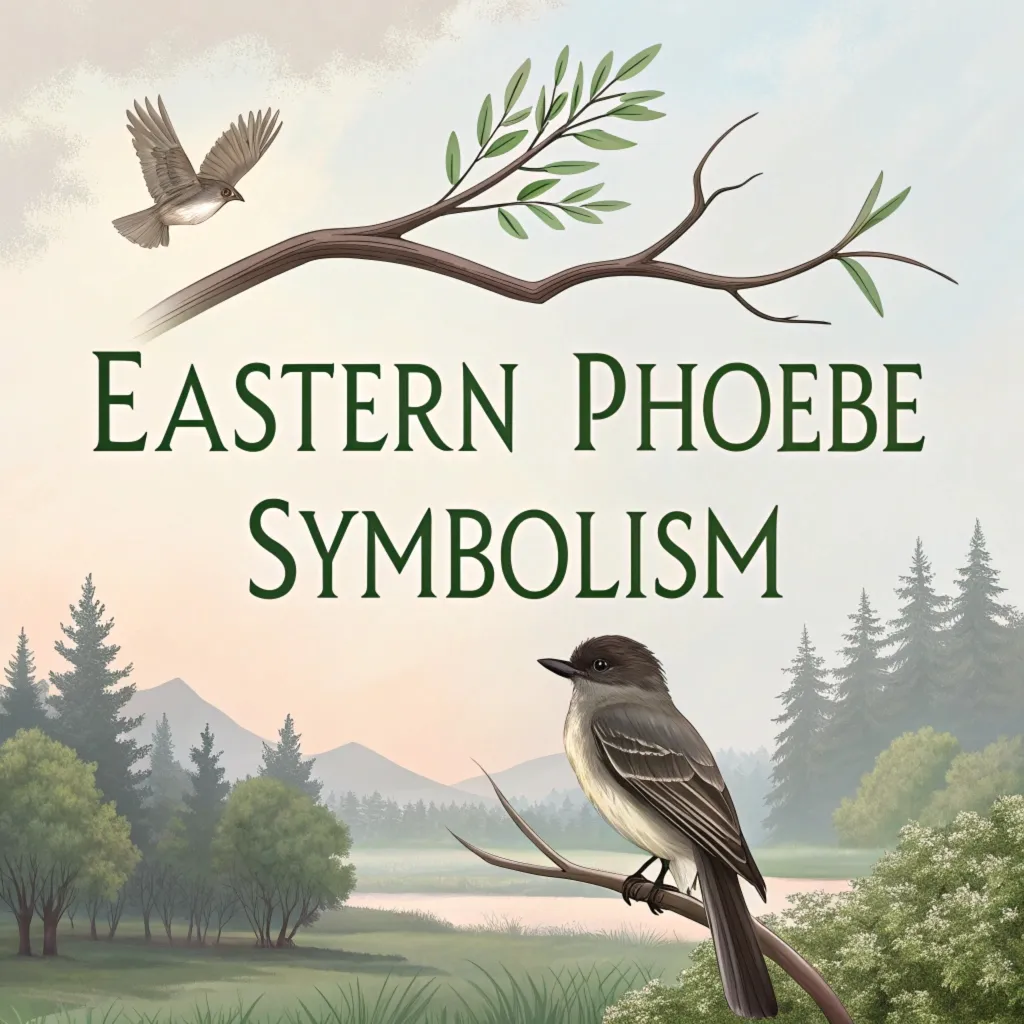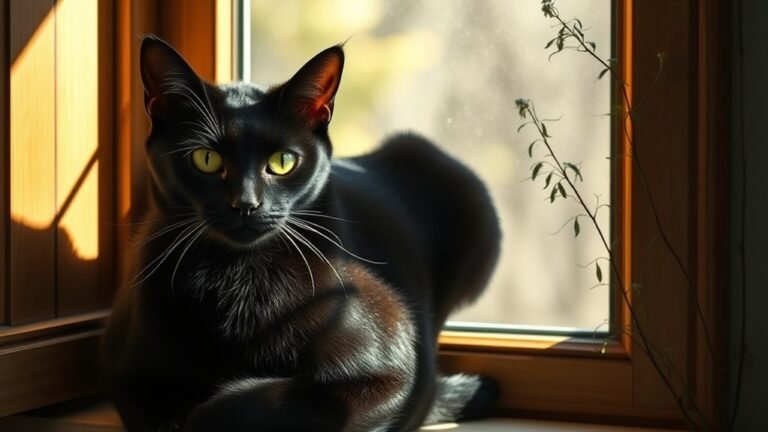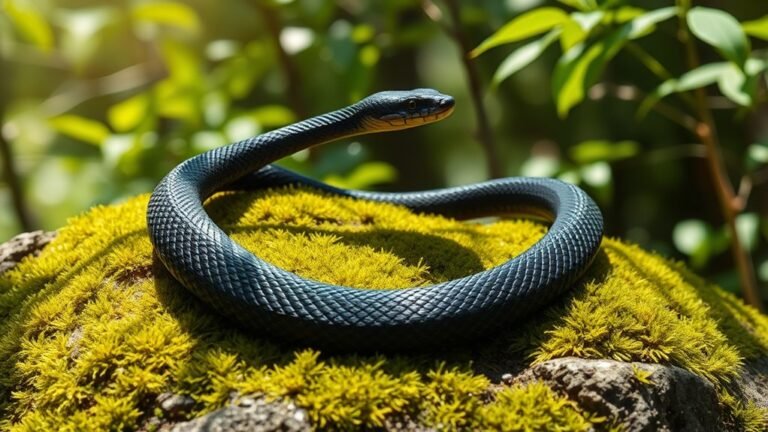Eastern Phoebe Animal Symbolism: Nature’s Messenger of Hope and Renewal
The Eastern Phoebe, a small yet captivating songbird, holds a special place in the realm of animal symbolism.
This unassuming creature, with its distinctive call and bobbing tail, carries profound meanings across various cultures and spiritual traditions.
As we delve into the rich tapestry of Eastern Phoebe symbolism, we uncover a world where nature’s wisdom intertwines with human perception, offering insights into life’s cycles, personal growth, and our connection to the natural world.
In this exploration, we will unravel the multifaceted symbolism of the Eastern Phoebe, from its role in Native American lore to its significance in Celtic traditions and Greek mythology.

Key Takeaways: Eastern Phoebe Symbolism
- Renewal and Change: The Eastern Phoebe symbolizes new beginnings and transformation.
- Spiritual Guidance: This bird serves as a messenger between earthly and spiritual realms.
- Resilience: The Phoebe embodies the ability to overcome challenges with patience and swift action.
- Optimism: Its presence inspires hope and positive outlook.
- Intuition: The Phoebe encourages trust in inner wisdom and instincts.
- Adaptability: This bird represents the capacity to thrive in various environments.
- Wisdom: In some cultures, the Phoebe symbolizes hidden knowledge and insight.
- Feminine Power: Greek mythology associates the Phoebe with feminine mystique and independence.
- Seasonal Transitions: The bird’s migration patterns connect it to the cycles of nature.
- Communication: Celtic symbolism views the Phoebe as a facilitator of spiritual communication.
- Balance: Eastern symbolism links the Phoebe to the harmony of yin and yang.
- Fidelity: Native American traditions associate the Phoebe with devotion in relationships.
- Spiritual Awakening: The bird’s song symbolizes the awakening of the soul.
- Freedom: The Phoebe’s flight represents liberation from constraints.
- Divine Guidance: Some cultures view the Phoebe as a guide for spirits in the afterlife.
Native American Symbolism of the Eastern Phoebe
Native American cultures view the Eastern Phoebe as a significant symbol. The bird represents a deep connection to nature’s cycles. Its arrival heralds spring’s return and renewal.
This small creature embodies rejuvenation. It reminds people of new beginnings with each season. Native Americans also associate the Phoebe with fidelity and devotion in relationships. The bird’s consistent return to its nesting sites mirrors loyalty in partnerships.
In many Native American tribes, the Eastern Phoebe is seen as a messenger of good fortune and positive change. Its distinctive call is often interpreted as a sign of impending transformation or a call to embrace new opportunities.
Some tribes believe that the Phoebe possesses the ability to bridge the gap between the physical and spiritual worlds, serving as a guide for those seeking wisdom or undergoing spiritual journeys.
The Eastern Phoebe’s nesting habits also hold symbolic significance in Native American lore. The bird’s tendency to build nests near human dwellings is seen as a sign of trust and harmony between humans and nature.
This proximity is often interpreted as a reminder of the interconnectedness of all living beings and the importance of maintaining a balanced relationship with the natural world.
Celtic Symbolism and the Eastern Phoebe
Celtic traditions attribute powerful symbolism to the Eastern Phoebe. The bird emerges as an emblem of communication and spiritual transcendence.
Celts often regarded the Phoebe as a messenger between Heaven and Earth. Its presence evokes connections between earthly and divine realms.
The Phoebe’s return in Celtic lands signaled a time of heightened spiritual communication. This belief underscores the bird’s role in bridging physical and metaphysical worlds.
In Celtic mythology, the Eastern Phoebe is often associated with the Otherworld, a realm of spirits and deities.
The bird’s ability to navigate between different environments – from forests to human settlements – symbolizes its role as a guide for souls transitioning between worlds. This connection to the Otherworld imbues the Phoebe with an aura of mystery and magic in Celtic lore.
The Phoebe’s song holds particular significance in Celtic traditions. Its melodious call is believed to carry messages from the divine, offering guidance and wisdom to those who listen closely.
Some Celtic stories depict the Phoebe as a shapeshifting being, capable of transforming into other creatures or even taking human form, further emphasizing its role as a mediator between different realms of existence.
Greek Mythology and the Phoebe Bird

Greek mythology links the Phoebe bird to profound symbolism. The name Phoebe connects to the goddess Artemis. This association embodies themes of femininity and nature.
As a lunar deity, Phoebe symbolizes intuition and introspection. The bird invites individuals to reflect on their inner selves. Greek myths portray the Phoebe as an oracle or seer.
This representation highlights the bird’s connection to wisdom and foresight.
In Greek lore, the Phoebe bird is often associated with the Titan Phoebe, grandmother of Apollo and Artemis.
This connection imbues the bird with qualities of ancient wisdom and prophetic abilities. The Phoebe’s association with lunar deities also links it to concepts of cyclical change and the ebb and flow of life’s rhythms, mirroring the waxing and waning of the moon.
Greek stories sometimes depict the Phoebe as a guardian of sacred spaces, particularly those associated with oracles and prophecy.
Its presence near temples or sacred groves was seen as a blessing from the gods, signifying divine approval and protection.
This aspect of Phoebe symbolism emphasizes the bird’s role as a bridge between the mortal world and the realm of the gods, serving as a conduit for divine wisdom and guidance.
Eastern Symbolism of the Phoebe Bird
Eastern cultures attribute unique symbolism to the Phoebe bird. It embodies the delicate balance of yin and yang. The Phoebe’s presence reminds people of harmony within duality.
Its ethereal nature serves as a metaphor for life’s contrasts. Eastern philosophy sees the Phoebe as a teacher of equilibrium. The bird’s behavior demonstrates the coexistence of opposites in nature.
In Chinese folklore, the Phoebe is often associated with the concept of Qi, or life force energy. Its graceful movements and ability to catch insects mid-flight symbolize the flow and balance of Qi within the natural world.
This association makes the Phoebe a powerful symbol of health and vitality in traditional Chinese medicine and philosophy.
The Phoebe’s migratory patterns also hold significance in Eastern symbolism. Its annual journey represents the cyclical nature of life and the importance of adapting to changing seasons and circumstances.
This aspect of Phoebe symbolism encourages individuals to embrace change as a natural part of existence, finding strength in flexibility and the ability to harmonize with the ever-shifting energies of the universe.
Spiritual Meaning of the Eastern Phoebe

The Eastern Phoebe carries deep spiritual significance. It resonates with core elements that guide people through life’s journey. The bird symbolizes faith in uncertain times. It embodies optimism and the embrace of hope.
The Phoebe represents rebirth after periods of stagnation. It teaches patience in the face of delays. The bird also symbolizes swift action when opportunities arise. Many see the Phoebe as a spiritual guide, helping others find their way.
In spiritual contexts, the Eastern Phoebe is often viewed as a messenger of personal transformation. Its appearance in one’s life may signal the need for introspection and the shedding of old patterns or beliefs.
The Phoebe’s ability to thrive in various environments serves as a reminder of the adaptability of the human spirit and the importance of remaining flexible in the face of life’s challenges.
The Phoebe’s distinctive call is sometimes interpreted as a wake-up call from the universe, urging individuals to pay attention to the signs and synchronicities around them.
This aspect of Phoebe symbolism encourages spiritual seekers to remain open and receptive to divine guidance, trusting in the wisdom that comes from both within and without.
The Eastern Phoebe as a Spirit Animal
As a spirit animal, the Eastern Phoebe offers powerful guidance. It signals times of spiritual renewal. The Phoebe’s appearance suggests the approach of new beginnings. This spirit animal brings gifts of optimism and fearlessness.
It encourages people to embrace change with confidence. The Phoebe spirit animal lifts spirits during challenging times. It reveals unseen paths and opportunities to those who connect with its energy.
When the Eastern Phoebe appears as a spirit animal, it often brings messages of self-reliance and inner strength. This bird’s solitary nature and ability to thrive independently remind us of our own capacity to stand on our own and trust in our abilities.
The Phoebe spirit animal encourages individuals to tap into their inner resources and find solutions within themselves.
Additionally, the Phoebe as a spirit guide emphasizes the importance of balance in one’s life. Just as the bird maintains equilibrium while catching insects mid-flight, it teaches us to find stability amidst life’s constant motion.
This spirit animal urges us to cultivate mindfulness and presence, staying grounded even as we pursue our goals and navigate life’s challenges.
Symbolism in Different Cultures
Various cultures interpret the Eastern Phoebe’s symbolism differently. In Chinese folklore, the bird represents good fortune and prosperity.
Its song heralds positive changes and new beginnings. European interpretations focus on the Phoebe’s migratory nature. Here, the bird symbolizes adaptability and resilience.
It inspires people to embrace change gracefully. These diverse cultural views highlight the Phoebe’s universal appeal as a symbol of hope and renewal.
In Japanese culture, the Phoebe is often associated with the concept of Wabi-sabi, which finds beauty in imperfection and transience.
The bird’s simple appearance and fleeting presence in different regions align with this aesthetic philosophy, reminding observers of the impermanent nature of all things and the beauty found in simplicity and natural cycles.
Native Hawaiian traditions view the Phoebe and similar flycatchers as guardians of the forest. These birds are believed to possess the ability to ward off evil spirits and protect sacred spaces.
This protective symbolism extends to the idea that the Phoebe’s presence near a home brings blessings and safeguards the inhabitants from negative energies.
The Phoebe’s Role in Nature and Spirituality
The Eastern Phoebe plays a vital role in both nature and spirituality. In ecosystems, it acts as a natural pest controller. Spiritually, it serves as a bridge between physical and metaphysical realms.
The bird’s behavior in nature mirrors spiritual lessons. Its consistent return to nesting sites teaches loyalty and perseverance. The Phoebe’s adaptability in various habitats inspires spiritual flexibility.
The Phoebe’s role in nature extends beyond pest control to include pollination and seed dispersal, contributing to the health and diversity of ecosystems.
This multifaceted ecological role mirrors the bird’s spiritual significance as a symbol of interconnectedness and the ripple effects of our actions on the world around us.
In spiritual practices, the Phoebe is sometimes invoked in meditation and visualization exercises.
Its swift, agile movements serve as a metaphor for the nimbleness of the mind and the importance of staying present and alert. The bird’s ability to catch insects mid-flight is seen as a spiritual lesson in seizing opportunities and acting decisively when the moment is right.
Lessons from the Eastern Phoebe
The Eastern Phoebe offers valuable life lessons. It teaches the importance of adaptability in changing circumstances.
The bird demonstrates resilience through its migratory patterns. It encourages trust in natural cycles and rhythms.
The Phoebe’s behavior shows the balance between action and patience. Its presence reminds people to stay connected to nature and inner wisdom.
One of the most profound lessons the Eastern Phoebe imparts is the power of persistence. Despite facing challenges such as habitat loss and climate change, these birds continue to return to their breeding grounds year after year.
This tenacity serves as an inspiration for humans to persevere in the face of adversity and remain committed to their goals and values.
The Phoebe also teaches us about the importance of timing. Its ability to catch insects in mid-flight demonstrates the value of patience combined with swift action when the moment is right.
This balance between waiting and acting decisively is a crucial skill in both personal and professional life, reminding us to be alert to opportunities while also cultivating the patience to wait for the right moment.
The Phoebe’s Influence on Human Perception
The Eastern Phoebe influences human perception of nature and spirituality. Its consistent presence in various cultures shapes beliefs about renewal and hope. The bird’s behavior inspires artistic and literary works.
It serves as a metaphor for personal growth and transformation in many traditions. The Phoebe’s symbolism affects how people interpret natural signs and omens.
The Phoebe’s influence extends to environmental conservation efforts. As a species that adapts well to human-altered landscapes, it serves as a bridge between urban and natural environments.
This adaptability has made the Phoebe a symbol of resilience in the face of environmental changes, inspiring conservationists and nature enthusiasts to find innovative ways to coexist with wildlife in developed areas.
In the realm of psychology, the Phoebe’s symbolism has been incorporated into various therapeutic approaches.
Its representation of renewal and adaptability is often used in cognitive behavioral therapies to help individuals overcome fear of change and develop more flexible thinking patterns.
The bird’s migratory nature also serves as a powerful metaphor for personal journeys and the courage to venture into unknown territories, both literally and figuratively.
Incorporating Phoebe Symbolism in Daily Life
People can incorporate Eastern Phoebe symbolism into their daily lives. Observing these birds can inspire moments of reflection and gratitude.
The Phoebe’s presence can serve as a reminder to embrace change positively. Its symbolism can guide decision-making processes. Meditating on the Phoebe’s qualities can foster personal growth and spiritual awareness.
One practical way to incorporate Phoebe symbolism is through mindfulness practices. Taking a cue from the bird’s alert and present nature, individuals can practice being fully engaged in the moment, whether in work, relationships, or personal pursuits.
This heightened awareness can lead to greater appreciation of life’s small wonders and improved decision-making skills.
Another approach is to use the Phoebe’s symbolism in goal-setting and personal development.
Just as the Phoebe returns to its nesting sites each year, individuals can set regular check-ins with themselves to assess their progress and realign with their core values and aspirations.
This practice of cyclical reflection and renewal can lead to more consistent personal growth and a stronger sense of purpose.
The Future of Phoebe Symbolism
The symbolism of the Eastern Phoebe continues to evolve. As environmental awareness grows, the bird’s significance as a nature symbol may increase. Its representation of adaptability becomes more relevant in rapidly changing times.
The Phoebe’s spiritual symbolism may expand to include modern interpretations. Its role in connecting people to nature may gain importance in urban societies.
As technology advances, the Phoebe’s symbolism may evolve to reflect modern concerns. Its adaptability could become a metaphor for navigating rapid technological changes. The bird’s resilience in urban environments may inspire eco-friendly urban planning and conservation efforts.
In the digital age, the Phoebe’s symbolism of communication may extend to ideas of connectivity and information sharing. Its ability to thrive in various habitats could symbolize the importance of maintaining work-life balance in an increasingly connected world.
The Phoebe’s role in connecting people to nature may become even more crucial as societies become more urbanized. Its presence in cities could serve as a reminder of the need for green spaces and biodiversity in urban planning.
FAQs About Eastern Phoebe Symbolism
What does the Eastern Phoebe represent in Native American culture?
The Eastern Phoebe symbolizes renewal, change, and the arrival of spring in Native American traditions. It’s associated with new beginnings and loyalty in relationships.
How is the Phoebe bird viewed in Greek mythology?
In Greek mythology, the Phoebe bird is linked to the goddess Artemis, representing femininity, intuition, and wisdom. It’s often seen as an oracle or seer.
What spiritual meanings does the Eastern Phoebe carry?
The Eastern Phoebe symbolizes faith, optimism, rebirth, patience, and spiritual guidance. It represents the ability to navigate life’s transitions with grace.
How does the Eastern Phoebe symbolize adaptability?
The bird’s ability to thrive in various environments and its migratory nature symbolize adaptability and resilience in the face of change.
What does the Phoebe’s song symbolize?
The Phoebe’s song often symbolizes hope, renewal, and the awakening of the soul. It’s seen as a harbinger of spring and new beginnings.
How is the Eastern Phoebe viewed in Celtic traditions?
In Celtic symbolism, the Eastern Phoebe is seen as a messenger between earthly and divine realms, facilitating spiritual communication.
What lessons can we learn from the Eastern Phoebe?
The Eastern Phoebe teaches us about adaptability, resilience, the importance of timing, and maintaining balance between action and patience.
How does the Phoebe bird influence human perception of nature?
The Phoebe’s presence shapes beliefs about renewal and hope, inspiring artistic works and influencing how people interpret natural signs and cycles.
What role does the Eastern Phoebe play in ecosystems?
In ecosystems, the Eastern Phoebe acts as a natural pest controller and contributes to pollination and seed dispersal, playing a vital role in maintaining ecological balance.
How can one incorporate Phoebe symbolism into daily life?
People can incorporate Phoebe symbolism by practicing mindfulness, embracing change positively, and using the bird’s qualities as inspiration for personal growth and decision-making.

Isabella is the author behind Divine Spiritual Path. With over a decade of experience in exploring various spiritual traditions and practices, she is passionate about sharing her insights and knowledge with others. Isabella believes that spirituality is a personal journey that can enrich our lives and foster deeper connections with ourselves and the universe. Through her writing, she aims to inspire and guide readers on their own paths to enlightenment and self-discovery.







